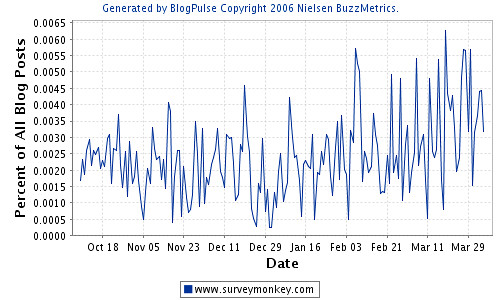While many so-called research methodology purists have criticized online surveys for leading to saturation, misuse and biased samples, they’ve also led to some interesting applications.
One such application is seeding online surveys in very specific online communities. A colleague of mine at Nielsen BuzzMetrics noted an experiment she conducted while earning her PhD at the
Another interesting use of online surveys is in the blogosphere. While usually not intended to achieve data representative of some specified group, bloggers frequently employ online surveys as mechanisms for conversation and peer-to-peer feedback, in real-time. For example, marketing pundit Joseph Jaffe frequently deploys online surveys to gauge opinions of his readers about a range of topics, such as “who is the most valuable blogger.â€
SurveyMonkey.com is among the most popular online survey tools in the blogosphere, perhaps because of its funny name and free services. Here is a BlogPulse chart indicating the percentage of total English-language blog posts which contain a SurveyMonkey link (typically for a survey).
Now onto the third application made possible by online surveys, which I concede I don’t have a very good real-life example of. We all know about viral ads, but what about viral surveys? What if the survey content, interactivity or outcome was so intriguing that a single respondent felt so compelled to pass it along (by any means) to five other friends? And what if that created a domino effect and really started to reach a critical mass, say hundreds, thousands or even millions of people? The respondents would have a bias of belonging directly or indirectly to a particular social network. But in many cases, that could be a very desirable characteristic. Of course, this method would never be too predictable or replicable. But the potential could justify the attempt.
Of course, all the above contributes to a glut of surveys and declining response rates. I’ll address that shortly.

